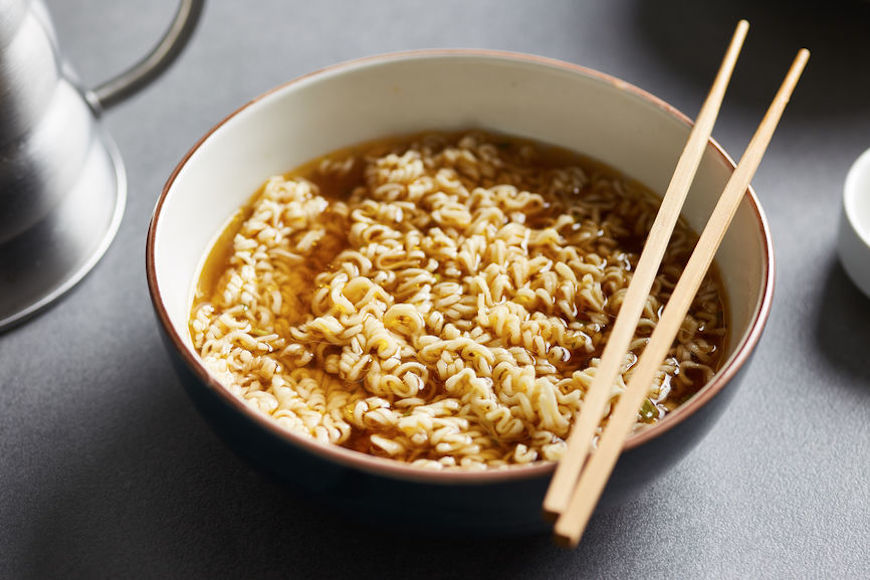
August 28, 2019 at 06:27PM by CWC
As far as packaged food goes, instant ramen—the beige block of dried noodles with its silver foil packet companion—is arguably the most iconic example that comes to mind. It’s many things—affordable, convenient, tasty—but has never been associated with health. One package of the leading brand of ramen has 1,660 milligrams of sodium, more than what the American Heart Association recommends most adults eat in an entire day. Other than protein, it has very few other nutrients to offer up—barely any fiber, and minimal vitamins.
Still, there’s something satisfying about dropping the noodle block into a pot of boiling water, breaking it up with a spoon, then stirring in the powdered flavoring in for a super quick dinner. And honestly, can you think of a more satisfying meal for less than a dollar?
Still, the idea that instant ramen could be transformed into a health food seems virtually impossible. But hey, other unlikely transformations have happened: just look at the cauliflower’s comeback as a healthier pizza and gnocchi option. Is it ramen’s turn to metamorphose into the next, greatest health food? These three brands certainly think so.
Giving craft ramen the ‘instant’ treatment
The brand: Mike’s Mighty Good
The healthy upgrade: While packaged instant ramen has essentially remained unchanged for decades, “craft” ramen found at ramen bars and restaurants has become more popular than ever in the United States. When making it at home, healthy foodies often use a collagen-rich bone broth base, fibrous veggies, and lean protein or eggs (a dietitian favorite), along with traditional spices and flavors. This is the type of ramen that Mike’s Mighty Good spent four years attempting to formulate and bring to the masses.
There are a few factors that set Mike’s Mighty Good apart from the OG instant packets. First, it’s organic. Second, the noodles are steamed, not fried. “Finding steamed—not fried—organic ramen noodles proved next to impossible, so we decided to make them ourselves,” says Carolyn Vinnicombe Yachanin, the brand’s chief evangelist and national sales and marketing lead. “Learning how to do this was extremely difficult and took years to master. We’re proud to say that we create each batch of noodles literally from scratch in-house and that we cook our noodles by steaming, never frying them.”
Vinnicombe Yachanin adds the brand crafted their products with nutrition in mind, too, calling out the lower sodium—720 milligrams per serving. Their soups also have about eight grams of protein (on average), which is double than what typical instant ramen has to offer.
What an RD thinks: To find out if these changes were enough to be considered legitimately healthy, I asked registered dietitian and Eating In Color author Frances Largeman-Roth, RD, what she thought. “I’ve tried Mike’s Mighty Good and it’s really delicious,” she says. But she says that despite best efforts, the sodium levels are still a bit high. “One soup is still almost half the sodium requirement for the day,” she points out. Her verdict is that it can be a decent meal option, as long as you’re mindful of your sodium intake the rest of the day, and isn’t something to be eaten daily.
The next Soylent?
The brand: Vite Ramen
The healthy upgrade: Of course Vite Ramen, the first nutritionally complete ramen available in the US, would come out of Silicon Valley. “I was eating ramen all the time because I really liked it. And my brother, who is a clinical nutrition major, would have a pure Soylent diet once finals week hit,” Vite Ramen co-founder Tim Zheng says. “It gave him all the nutrition he needed, but he wasn’t happy because he wasn’t eating real food. And I was happy because I love ramen, but I wasn’t getting the nutrition.”
One day, while Zheng was adding eggs to his instant ramen, he complained aloud to his brother, Tom, wishing his favorite food had all the nutritional requirements he needed. That was their lightbulb moment, leading the brothers on a years-long process to turn the classic noodle dish into the next superfood.
Zheng explains that one of their goals was to get the sodium below 25 percent of the recommended daily intake—which became even more difficult when the AHA lowered their daily sodium recommendations from 2,300 milligrams to 1,500 milligrams while they were in the thick of formulating their ramen. Still they got it there—to 575 milligrams. One package of noodles also has 27 to 30 grams of protein (sourced from grains including quinoa and vital wheat gluten), 11 to 12 grams of fat, and 65 to 70 grams of carbohydrates, depending on the flavor.
Along with the seasoning packet, each Vite Ramen comes with a unique vitamin blend (called “noodtrients”), which has 25 percent or more of the daily value of every essential vitamin and mineral needed daily. “Each ramen flavor actually has a different ‘noodtrient’ blend because the nutritional profile you’re getting from the chicken flavor, for example, is going to be different than what you get from the vegan miso.” Each individual nutrient added to each of the three blends was sourced and tested individually to ensure it could withstand heat (since, you know, ramen typically requires boiling water).
While the product is pretty revolutionary, Zheng says they aren’t done perfecting it. “Tom and I always thought it was weird that unlike technology, food products are often released and that’s it, there’s no 2.0 or 3.0,” Zheng says, teasing that they are close to coming out with a keto-approved ramen.
ADVERTISEMENT
ADVERTISEMENTSports Direct Free Delivery on All Orders! |
What an RD thinks: “Wow, this one really packs the nutrients!” Largeman-Roth says, after looking into Vite Ramen. “At 500 calories or more, it’s higher in calories than a typical ramen cup and somehow they keep the sodium reasonable.” Overall, she gives it a thumbs up, but she warns against replying on Vite Ramen to get all your nutrients while *also* taking a multivitamin or other supplements, saying it could lead to vitamin or mineral overload. Plus, she still sees is more of a “sometimes” meal, not an everyday one. “I’d rather see folks taking a basic ramen and loading it up with fresh shrimp, chicken, eggs or tofu and fresh veggies and herbs,” she says. “You just can’t rely on a diet of packaged food for total health!”
The packaged ramen giant going healthier
The brand: Nissin
The healthy upgrade: Vite Ramen isn’t the only Soylent-esque product; Cup Noodle maker Nissin recently launched a new product in Japan called All, with a similar concept. “In modern Japan, there are many young people who do not have enough calories per day, or many who have enough calories but not enough nutrients. Therefore, we decided to develop a product that not only makes it easy to ingest the nutrients necessary for a day, but also makes it easy for anyone to cook, tastes well, and can be stored at room temperature for a long time,” says Haruka Aoki, a communication specialist for the brand.
One package has over a third of the body’s daily requirements for 13 different vitamins, 13 minerals, protein, and fiber—and the carbs are 40 percent less than in the OG Cup of Noodles. Aoki says the brand experimented with many different nutrient sources and it was tricky to get the ramen to taste just right, while also hitting the health goals. “It was very difficult. Many of the nutrients are accompanied by bitterness and harsh taste,” she says. The method that proved to work: using technology to get the nutrients inside the noodles, which are made of wheat protein and tapioca (the soup’s main fiber source).
Aoki says there are no plans—yet—to bring All to the States, but the brand recognizes that healthy ramen has become a food on many consumers’ wish list. “When Momofuku Ando [the founder of Nissin and inventor of instant ramen noodles] developed his innovation of instant noodles 61 years ago, he set forth five key principles: delicious taste, safety, convenience, preservability, and affordability,” she says. “However, people’s interest in nutrition and health is rapidly increasing with changes in consumer awareness and social environment. In order for instant noodles to contribute to the happiness of future humanity, it is the duty of all manufacturers to commit to the health and wellbeing of people.”
What an RD says: Similarly with Vite Ramen and Mike’s, Largeman-Roth sees Nissin as another “occasional” food, not one to have for dinner every night. “I understand that some people are not very interested in having variety in their diet, so the concept of eating or drinking one product and getting all of their nutrients from it seems super efficient and easy. The truth is that you really can’t package the benefits of eating a diet of fresh fruits and vegetables, whole grains, nuts and seeds, lean protein, and dairy,” she says. “There are phytonutrients that come with whole foods that can’t be isolated and added to packaged foods. Plus, a one-note diet, even if it is something as delicious as ramen, isn’t good long-term for the body or the soul.”
In general, it’s great instant ramen is getting a makeover—just don’t think the nutritional improvements make it worth adding to your daily lineup. But next time that craving for ramen hits, it’s nice to know there’s options out there that aren’t just sodium bombs.
Something else that’s getting a healthy glow-up: the humble TV dinner, which is just part of the makeover the frozen food section is experiencing.
Author Emily Laurence | Well and Good
Selected by CWC
ADVERTISEMENT
ADVERTISEMENTUp to 30% off Gift Sets |








